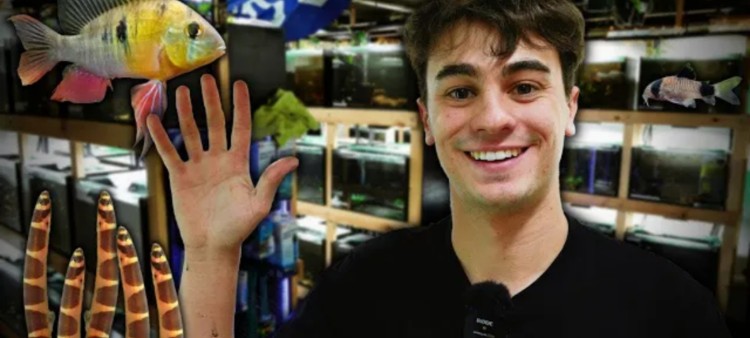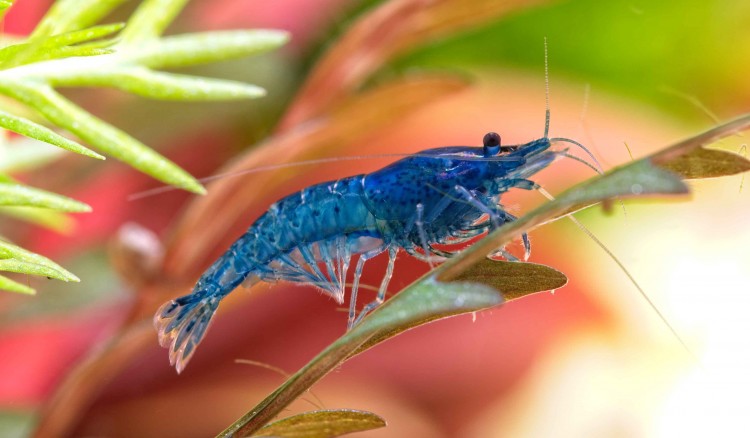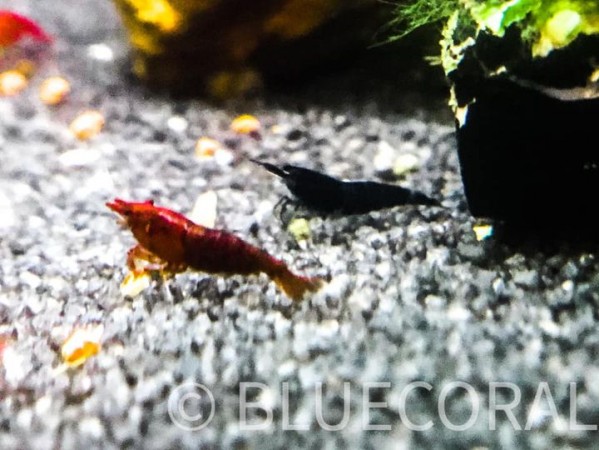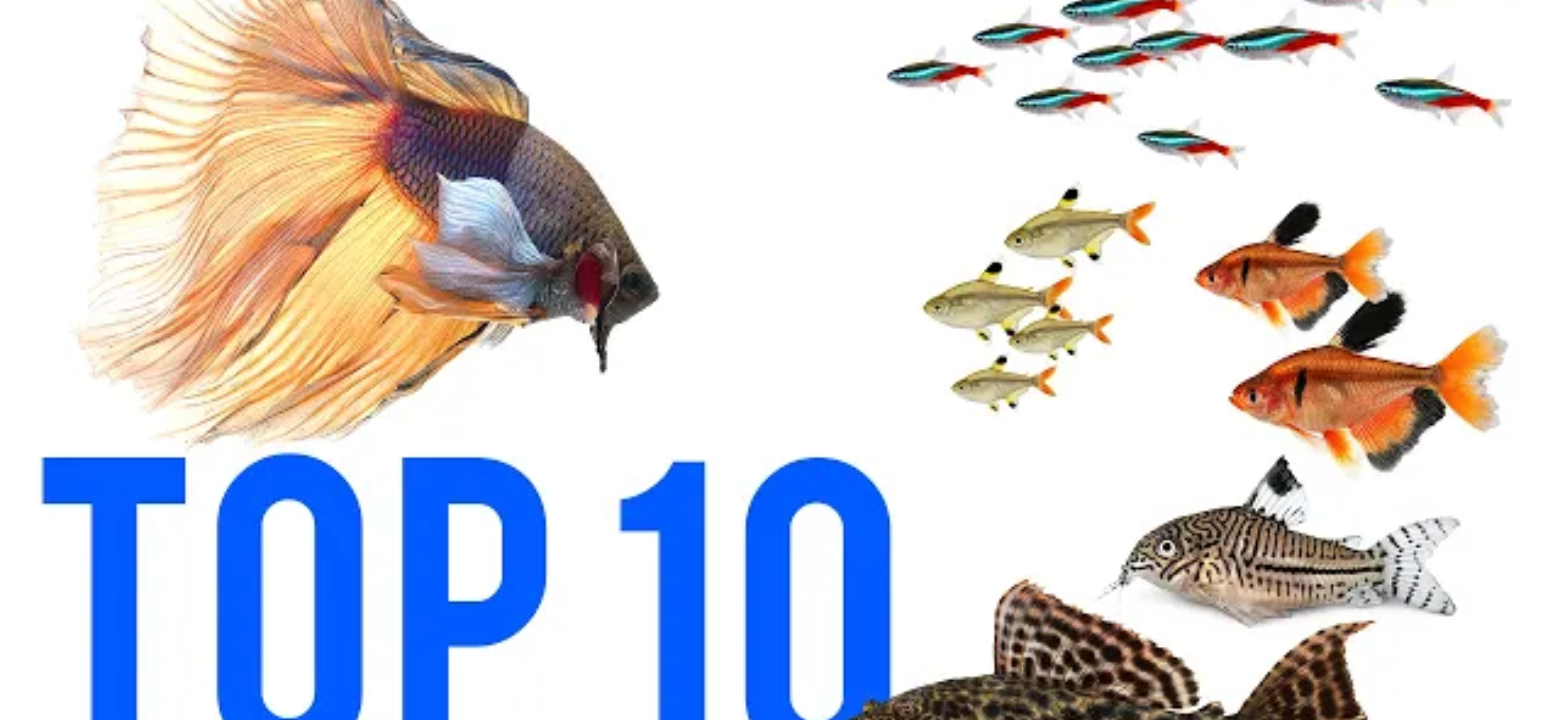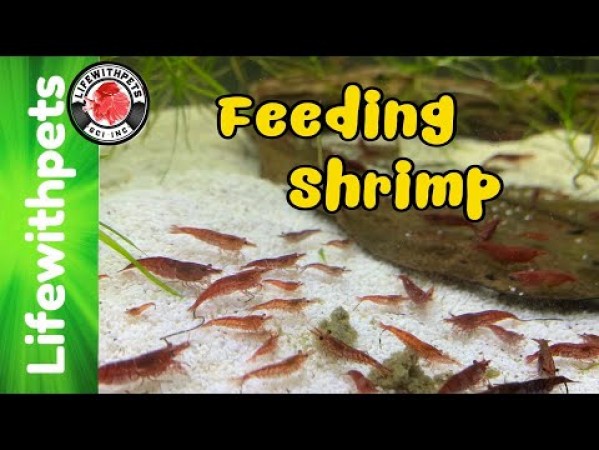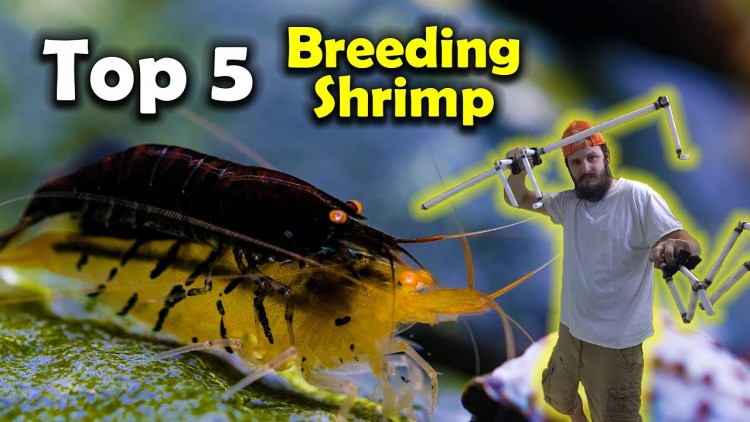- Name:
Viper Shrimp
(View AKA's) - Family: Atyoidea
- Species: Shrimp
- Scientific Name: Atya gabonensi
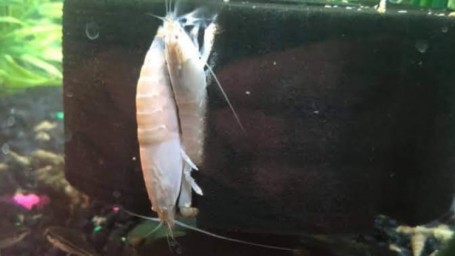

General info about Viper Shrimp
Viper Shrimp is also known as African Fan Shrimp, Giant African Fan Shrimp, African Filter Shrimp, Giant African Filter Shrimp, Gabon Shrimp, or Vampire Shrimp, are natives of parts of Western Africa and parts of South America. Vampire Shrimp are fan feeders that snatch their food from the water current in the tank with their little-fanned hands. Their fascinating behavior, intense coloration, long life expectancy and relative scarcity in the hobby make them a true showcase species. If a tank is stable and healthy and the shrimp is well fed and cared for, unlike other shrimps viper shrimp should last a pretty long time(up to 5 years under the right conditions!).
In the wild, they typically live in small, fast-flowing to rapid mountainous streams, gripping stony bedrock directly in the current with their powerful back claws and legs. They use their fan-like front appendages to filter very fine floating food items (such as mosquito larvae, daphnia, and Cyclops, as well as small algae particles) from the current. During daylight, they typically seek shelter under rocks and logs. They come out of hiding at twilight or in darkness in order to feed.
Viper Shrimp color ranges between a light blue-ish grey and darker shades of blue-ish grey. Sometimes their color can shift to have a cream color, a pink color, or even a hint of green added in. Other possible colors can include a rusty maroon or brown, and even straight blue. Viper Shrimp have a deeply furrowed, wrinkly carapace. Coloration varies from blue, gray, white after molting, and increasingly blacker as they age. Viper Shrimp molting seems to occur once every couple of months. It will grow a new shell under his present one. When molting occurs, the shrimp will crack out of its old shell leaving it behind. During the molting process, a Viper Shrimp probably feels very vulnerable. So it will look for a quiet and safe place to hide. A common molting hiding spot is behind a power filer water intake. So make sure there are a couple of spots like this for your shrimp to find when molting time comes. Also, it’s a good idea to leave the empty shell in the tank for a day or so, because other shrimp seem to like to eat the discarded shell. However, if the discarded shell is not eaten, removing it is important to sustain water quality. Uneaten food can result in unbalanced water parameters, which are often fatal to freshwater shrimp.
Despite their somewhat "demonic" appearance, they are absolutely peaceful and harmless fan shrimp. At the same time, ViperShrimp seems to be very social with other filter shrimp. They appear to be very comfortable hanging out in the water current with other freshwater shrimp, especially Bamboo Shrimp. It is possible to house them in a community aquarium with small peaceful fish. In the aquarium, there should be a couple of places to hide: under rocks and decorations, under thick plants, or around a sponge filter.
Although this species is completely safe for dwarf shrimp aquariums, it does not tolerate temperatures as low as the temperatures that most dwarf shrimp enjoy. The Vampire Shrimp requires oxygen-rich water with a heavier current than many other shrimp species. Water temperature should between 74 – 84 Degrees Fahrenheit and pH level is between 7.0 – 7.5. Although some sources suggest a pH as low as 6.5 is suitable as well. They also seem to be healthy with aquarium water that is on the hard side, with a constantly moving oxygen-rich current and sufficient water flow. 3-10 dkH is necessary to maintain a healthy aquarium. Since they prefer oxygen-rich water and strong current, use a submersible pump to keep water in constant circulation.
Viper Shrimp need a decent amount of water volume to feed, so the bigger the tank, the better. A 20-gallon aquarium can be a good tank size to start with. Of the 20 gallon tanks, a 20-gallon long tank can be a good choice because the dimensions are 30 x 12 x 12. A 30-inch length means there is a decent amount of aquarium bottom to walk on. The 12-inch height means it isn’t very hard to keep the water current moving quickly throughout the tank.
Viper Shrimp size is generally about two to three inches in length, although lengths up to six inches is possible. Another observation about Viper Shrimp size is that they are “thicker” looking that other aquarium shrimp. Compared to the thinner and more streamlined Bamboo Shrimp, Viper Shrimp look more “heavy-duty” shell-wise. Maybe it is the actual thickness of their torso and tail, or maybe its the thickness of their legs, but Vampire Shrimp have a boxy size and appearance.
Another interesting observation is that they have little bumpy points on their sides of their legs and one larger point on the end of their legs. Perhaps these points are necessary to help wild Vampire Shrimp hold on to wood, rocks or sticks as they face strong currents. In any event, the heavy-duty look and points on their legs give Viper Shrimp a menacing appearance. But nothing can be further from the truth. These shrimp are one of the most docile and harmless inhabitants in a tank.
Viper Shrimp also have long slender antennae on the top of their heads. Perhaps these feelers come in handy when they move around at night.
Viper Shrimp Diet & Nutrition
The Viper Shrimp is a filter feeding shrimp and will position itself in areas of highest water flow and use its filtering appendages to pull microorganisms, shed plant matter, algae, biofilm, and other fine food items from the water. In aquariums with multiple specimens, it is fun to see several of these shrimp gathered in one area feeding together.
Viper Shrimp are filter feeders so there should be plenty of food floating in the water column to keep them well fed. Keeping a tank well planted is a good idea because live aquarium plant shed little bits of edible matter into the tank water. Live plants also give shrimp places to explore, climb on and hide in. Aquariums with live plants are traditionally a little messier than tanks with plastic plants. Live aquarium plants prevent the tank from becoming “too clean”. Tanks that are “too clean” may not have enough natural edible matter floating around for these shrimp to eat. In addition to this, it’s also a good idea to supplement their diet with food made up of finely ground fish pellets, shrimp pellets, finely ground algae wafers or small flakes sparingly. These can be ground into a fine powder and added to the current upstream of the Viper Shrimp. A pinch or two at the time will cause the food particles hit the shrimp square in its filter fans. After a few tries, it’s easy to get the hang of it.
Determining Sex of Viper Shrimp
Males are generally larger and bulkier than the females.
Breeding & Spawning Viper Shrimp
This shrimp is known as a low-form spawner, meaning that its fry go through several complex larval planktonic stages in a wide variety of water conditions, including brackish and marine salinity. As a result, large-scale spawning in captivity has not yet been reported.
Viper Shrimp Origin
Origins from West Africa and South America.
Caution with Viper Shrimp
Like all invertebrates, it is extremely sensitive to copper and must never be exposed to this metal, even in very small amounts. Shrimps are highly sensitive to heavy metals and a number of chemical compounds. This comes into consideration most often when looking at medications. Most aquarium medicine contains copper or other substances that are lethal to invertebrates, even in low doses. Do everything you can to avoid medicating a shrimp tank.
Keep Ammonia and Nitrite levels in zero and nitrates under 20. Viper Shrimp care should be easy provided good fish keeping habits are present: regular partial water changes, frequent water testing, avoiding overfeeding, avoiding overstocking, and the like.
Original Detail
| Name | Species | Family | Scientific Name | More Detail | Added by |
|---|---|---|---|---|---|
| Viper Shrimp | Shrimp | Atyoidea | Atya gabonensi | Viper Shrimp is also known as African Fan Shrimp, Giant African Fan Shrimp, African Filter Shrimp, Giant African Filter Shrimp, Gabon Shrimp, or Vampire Shrimp, are natives of parts of Western Africa and parts of South America. Vampire Shrimp are fan feeders that snatch their food from the water current in the tank with their little-fanned hands. Their fascinating behavior, intense coloration, long life expectancy and relative scarcity in the hobby make them a true showcase species. If a tank is stable and healthy and the shrimp is well fed and cared for, unlike other shrimps viper shrimp should last a pretty long time(up to 5 years under the right conditions!). In the wild, they typically live in small, fast-flowing to rapid mountainous streams, gripping stony bedrock directly in the current with their powerful back claws and legs. They use their fan-like front appendages to filter very fine floating food items (such as mosquito larvae, daphnia, and Cyclops, as well as small algae particles) from the current. During daylight, they typically seek shelter under rocks and logs. They come out of hiding at twilight or in darkness in order to feed. Viper Shrimp color ranges between a light blue-ish grey and darker shades of blue-ish grey. Sometimes their color can shift to have a cream color, a pink color, or even a hint of green added in. Other possible colors can include a rusty maroon or brown, and even straight blue. Viper Shrimp have a deeply furrowed, wrinkly carapace. Coloration varies from blue, gray, white after molting, and increasingly blacker as they age. Viper Shrimp molting seems to occur once every couple of months. It will grow a new shell under his present one. When molting occurs, the shrimp will crack out of its old shell leaving it behind. During the molting process, a Viper Shrimp probably feels very vulnerable. So it will look for a quiet and safe place to hide. A common molting hiding spot is behind a power filer water intake. So make sure there are a couple of spots like this for your shrimp to find when molting time comes. Also, it’s a good idea to leave the empty shell in the tank for a day or so, because other shrimp seem to like to eat the discarded shell. However, if the discarded shell is not eaten, removing it is important to sustain water quality. Uneaten food can result in unbalanced water parameters, which are often fatal to freshwater shrimp. Despite their somewhat "demonic" appearance, they are absolutely peaceful and harmless fan shrimp. At the same time, ViperShrimp seems to be very social with other filter shrimp. They appear to be very comfortable hanging out in the water current with other freshwater shrimp, especially Bamboo Shrimp. It is possible to house them in a community aquarium with small peaceful fish. In the aquarium, there should be a couple of places to hide: under rocks and decorations, under thick plants, or around a sponge filter. Although this species is completely safe for dwarf shrimp aquariums, it does not tolerate temperatures as low as the temperatures that most dwarf shrimp enjoy. The Vampire Shrimp requires oxygen-rich water with a heavier current than many other shrimp species. Water temperature should between 74 – 84 Degrees Fahrenheit and pH level is between 7.0 – 7.5. Although some sources suggest a pH as low as 6.5 is suitable as well. They also seem to be healthy with aquarium water that is on the hard side, with a constantly moving oxygen-rich current and sufficient water flow. 3-10 dkH is necessary to maintain a healthy aquarium. Since they prefer oxygen-rich water and strong current, use a submersible pump to keep water in constant circulation. Viper Shrimp need a decent amount of water volume to feed, so the bigger the tank, the better. A 20-gallon aquarium can be a good tank size to start with. Of the 20 gallon tanks, a 20-gallon long tank can be a good choice because the dimensions are 30 x 12 x 12. A 30-inch length means there is a decent amount of aquarium bottom to walk on. The 12-inch height means it isn’t very hard to keep the water current moving quickly throughout the tank. Viper Shrimp size is generally about two to three inches in length, although lengths up to six inches is possible. Another observation about Viper Shrimp size is that they are “thicker” looking that other aquarium shrimp. Compared to the thinner and more streamlined Bamboo Shrimp, Viper Shrimp look more “heavy-duty” shell-wise. Maybe it is the actual thickness of their torso and tail, or maybe its the thickness of their legs, but Vampire Shrimp have a boxy size and appearance. Another interesting observation is that they have little bumpy points on their sides of their legs and one larger point on the end of their legs. Perhaps these points are necessary to help wild Vampire Shrimp hold on to wood, rocks or sticks as they face strong currents. In any event, the heavy-duty look and points on their legs give Viper Shrimp a menacing appearance. But nothing can be further from the truth. These shrimp are one of the most docile and harmless inhabitants in a tank. Viper Shrimp also have long slender antennae on the top of their heads. Perhaps these feelers come in handy when they move around at night.
|
PalaciosAn |
Changed by users
| Submitted Date | Submitted By | Status | Action |
|---|


